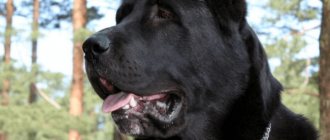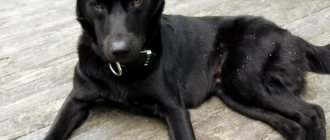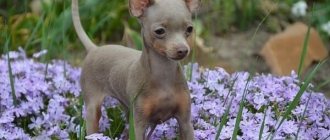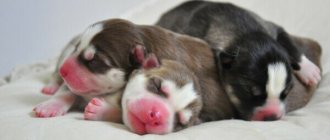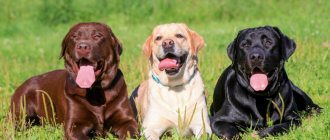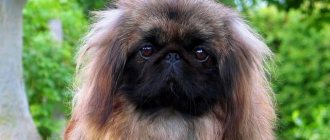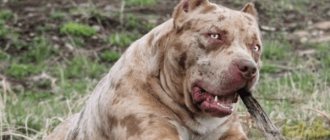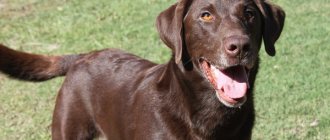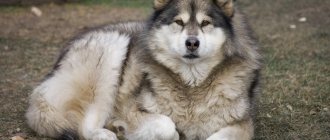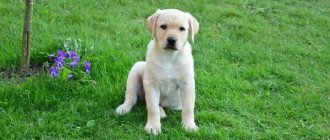Today, Husky is a fairly well-known breed that only the lazy don’t know about.
However, among all the varieties, people first of all remember the Siberian Husky.
However, this is not surprising - it is the most common.
What can we say about the Sakhalin resident, who is completely under threat of extinction, despite all the advantages and advantages that this breed has.
Caring for Sakhalin residents
Laika is quite unpretentious in its care; special attention should be paid to its fur. Shedding twice a year, does not have a bright characteristic odor, with careful care and proper nutrition, the dog will live a long and high-quality life
- Grooming: Brush your dog thoroughly twice a week. After walks, dirt or debris may remain in the fur; inspect carefully when you get home. During the molting period, daily combing will be required; a slicker brush is best suited for this. Every day after walking, it is recommended to wipe the wool with a damp cloth to remove dust. Treating wool against parasites during the season.
- Bathing: when soiled, do not use human products, only dog shampoos and conditioners. The water should not be hot. Many people swim in open waters; after such procedures, rinse your pet with running water. After walks, wash paws and let the coat dry.
- Ears: treat regularly - 2 - 3 times a month, clean out excess with special swabs or cotton pads moistened with a special care lotion. Do not use hydrogen peroxide; the dog may get scared and stop letting his ears be cleaned. Be careful not to press too hard or go deep into the passage itself, otherwise damage may occur.
- Eyes: wipe with a cotton pad or gauze pad, a specialized care lotion is suitable, sold in veterinary stores.
- Nails: cut when they grow, accustom them to cutting from childhood. To do this, purchase a nail clipper.
- Teeth: check for diseases, examine the mouth, monitor the color of the mucous membranes, the smell. Give “sticks – bones”, which are intended for cleaning plaque.
- Vaccinations: regular according to age. Visit a doctor once every 6 months for examination. An anthelmintic will need to be given every 4 to 6 months.
- Physical activity: regular, walking 2 times a day, active games, the opportunity to run freely and without restrictions.
Performance evaluation and information
Individuals of this breed are quite large in size and weight. The average adult dog reaches a height at the withers of up to 70 cm, while its weight can be about 30-40 kg. Such a large body structure was noticed by man since ancient times, so ancient tribes began to domesticate the breed.
Thus, this animal became one of the oldest domestic animals ever used by man.
All representatives have small ears, pointed at the tip, and their position is slightly tilted forward. The husky's limbs are also large and powerful; with their help, the animal can overcome any physical activity without much difficulty.
When it comes to coat colors, several shades can predominate here: white, black, red or gray. Animals with a tiger color have the greatest value (especially among the natives of the Amur region).
Coat
The coat is dense and dense with a soft undercoat. Longer cover on the front of the limbs and muzzle. The color can be different, but monochromatic animals are more common: red, gray, black. There are also brindle colors, but the spots in this case are quite small.
It is interesting that the Nivkhs especially valued this particular Sakhalin husky. The completely white color is almost never found.
Training
Dog handlers claim that Gilyak Laikas are capable of training and learn all programs. You just need to deal with such a self-sufficient dog by a professional who can find an approach to such an obstinate dog.
Huskies can master all basic programs
Therefore, the owner of a Sakhalin Husky, especially in urban conditions, should enroll in a club to undergo a training program in a group or individually, and at the same time learn to find a common language with his pet.
Physical punishment is unacceptable for Karafuto-Ken! Otherwise, the dog will cease to respect and obey its owner.
Origin story
The indigenous dog breed originated on the Sakhalin Peninsula and surrounding areas many years ago. The local people, the Gilyaks, used large and strong animals to transport goods, and often took dogs with them to hunt large animals. Among themselves, they called their pets Gilyak Laika.
The breed of hardy and beautiful dogs fell in love with the Japanese, who call them karafuto ken, which means a dog from the Sakhalin Peninsula. The Japanese take good care of the Sakhalin Husky population in their country and use individuals to restore the ancient Japanese Akita Inu breed.
Currently, Gilyak dogs are almost extinct; there are only a few dozen of them left. Cynologist enthusiasts from Japan and Russia are making every effort to restore the breed.
Pros and cons of the breed
The advantages and disadvantages of Sakhalin Huskies are presented in the table:
| + | – |
| Strong and hardy dogs with preserved working qualities | The small number of individuals leads to difficulties in breeding |
| Easy to care for | Not suitable for apartment living |
| Well trained | High price |
| Presence of hereditary diseases |
Where to buy
Currently, the number of dogs belonging to the Sakhalin Huskies is small, there are only a few dozen of them. You can choose a puppy with a pedigree and all the necessary medical certificates in a Japanese nursery on the island of Hokkaido. In Russia, today, only the Lightkeeper club in Moscow officially deals with Sakhalin Huskies. The price for puppies of an endangered breed is high, ranging from 40,000 to 70,000 rubles.
Amazingly beautiful, smart and strong dogs should not disappear. Northern dog lovers are making every effort to preserve this universal breed - the Sakhalin Husky.
Sakhalin Husky (Karafuto-ken, Sakhalin Laika, Gilyatskaya Laika)
- The official name is Sakhalin Husky.
- FCI classification - not recognized.
- Origin – Russia.
- Patronage – Japan.
- Dimensions: 56–66 cm.
A large, strong, independent breed bred to transport goods. Considering the age of the breed group, it can be assumed that the Sakhalin Huskies were repurposed from hunting and herding dogs into sled dogs. It is known that at the time of its inception, among local tribes, baiting of bears with dogs served as entertainment. Having gone through a long journey of formation, Karafuto-ken acquired a calm and reasonable disposition, good health, endurance and incorruptible devotion to the owner.
In 1958, 15 Sakhalin Huskies were forced to live in the Antarctic desert. The expedition members could not return for the animals because the weather conditions threatened people's lives. They returned for the dogs a year later. Two miraculously surviving Huskies were discovered near the abandoned camp. Based on these events, the films “Antarctica” and “White Captivity” were made. In the film “White Captivity”, the role of Sakhalin Huskies was played by Malamutes and Siberian Huskies.
External links [edit]
| Wikimedia Commons has media related to Sakhalin Huskies . |
- Photos of Sakhalin Huskies
- "Hana, Karafuto Ken (The Last Surviving Sakhalin Husky)". Retrieved March 17, 2013.
| Spitz-type dogs | |
| Sled dogs |
|
| Hunting dogs |
|
| Herding dogs |
|
| Asian breeds |
|
| Companion dogs |
|
| Extinct breeds |
|
| Types: Husky, Laika |
| vteDogs from Russia | |
| Preserved |
|
| Extinct |
|
Health and major diseases, life expectancy
The selection of huskies took place in harsh conditions, so their representatives are distinguished by good health and longevity. On average, the lifespan of an animal varies from 12 to 16 years, which is undoubtedly a plus for owners. However, this does not save dogs from diseases, which are most often expressed by genetic disorders.
These include:
- diseases of the endocrine system (for example, diabetes);
- eye diseases (glaucoma, cataracts, lens opacity);
- disruptions in the cardiovascular system;
- pathologies of the musculoskeletal system;
- allergic reactions;
- dermatological diseases (most often in males);
- immunodeficiency.
How to choose?
On average, puppies are given to new owners at the age of 8 weeks.
It is then that you can judge the external characteristics of the pet and their compliance with the breed standard:
- head – large, narrowed towards the nose;
- the eyes are slightly slanted, mostly almond-shaped;
- the ears are erect, set high and in the shape of a pronounced triangle;
- the limbs are strong, muscular, the paws are large;
- tail – pubescent, straight.
Kai (Kai-ken, Tora-inu, Tiger dog)
- The official name is Kai.
- FCI classification – group 5, section 5, standard No. 317.
- Origin and patronage - Japan.
- Dimensions: 45–56 cm.
An aboriginal hunting dog that was long considered a mongrel. Having formed without human intervention, Kai retained good health and a specific disposition. However, the “first owners” were more than happy with the dog’s independence. The four-legged animals helped hunt medium and large game, guarded property, protected their owners, and otherwise remained wild. Modern representatives of the breed have retained pack communication skills, that is, one of the family members becomes the leader, and the rest are regarded as equals.
Origin story
The breed was formed from medium-sized dogs that were found in the Kai area (Yamanashi Prefecture) since ancient times. The region's surroundings with mountains and the developed pack instinct of local dogs allowed them to develop in isolation and maintain breed purity. In 1931, dog handler Dasuke Odachi from Kofu, the capital of Yamanashi, impressed by the unusual color of these dogs, began work to preserve the breed. In the same year, the Society for the Protection of Kai was created, which still remains the main organization registering the breed.
Since 1934, the breed has been protected by the state and prefecture. She is recognized as a national treasure of Japan along with five others: Akita, Kishu, Shiba, Shikoku and Hokkaido. Even for Japan the breed is considered rare. Only about 1,000 puppies are registered each year. In 1982, the breed was officially recognized by the International Canine Federation.
Purpose and hunting with kai-ken
In Japan, taro brindle dogs have always been valued for their innate hunting talents. Owners from Yamanashi Prefecture still hunt goat antelope with them. It is worth noting that kai are universal, they can be trained on any medium or large-sized animal and even a bird. They are passionate, hardy, dexterous and brave, and will not retreat from a boar or bear. They work as hunter's assistants, tracking and holding prey, but they can hunt independently, in which case they immediately kill the trophy. They have a very good sense of smell.
Very rarely, kai are used in other work: as shepherd dogs guarding the herd, fishermen's assistants (for driving fish into nets) and in the search and rescue service.
Video about the kai dog breed (kai-ken):
Selection and price of a puppy
How much do husky puppies cost? In fact, the price can be from 25 thousand rubles. up to 50 thousand rubles* It all depends on the type of breed and the nursery from which the kitten is taken. The largest establishments where purebred dogs are sold are located in Moscow. The second place where you can pick up a husky puppy for a price above average is St. Petersburg.
Note! If you don’t plan to take a dog for a show, you can get by with a more budget option
But you need to be careful and get to know the puppies’ parents or study their documents. Otherwise, you can buy a very expensive mixed breed that will simply look like a purebred, or a dog with congenital defects
Otherwise, you can buy a very expensive mixed breed that will simply look like a purebred, or a dog with congenital defects.
So who should own a husky? It should be understood that this is not a lap dog; it needs space and movement. Therefore, it is recommended to keep them in private houses or apartments, but on condition that the owner can take care of such a temperamental dog.
*Prices are as of November 2022.
Price range
This is a rare breed, so buyers are very limited in their choice of sellers and kennels . In addition, problems such as, for example, a shortage of assortment lead to an increase in the cost of goods or services offered.
Accordingly, buying a Sakhalin Husky puppy is not a cheap pleasure.
The cost of puppies depends on the class of the pet, its pedigree and other qualities.
Let's consider three basic options:
| Class | Characteristic |
| Pet class | The pet has minor defects, which, although they do not affect the dog’s health, become an obstacle to further breeding and participation in exhibitions. The cost of such a puppy is 20 thousand rubles. |
| Breeding class | Puppies that meet the standard and are approved for breeding. The price varies from 35 thousand rubles. up to 40 thousand rubles. |
| Show class | A pet with the highest characteristics and no less prospects. This is a future champion of dog shows and an enviable father/mother for future offspring. The cost of such puppies is not less than 50 thousand rubles. |
The Sakhalin Husky appears to be an amazing animal, a devoted friend and a good helper.
He is distinguished by his loyalty and complaisance, is unpretentious in everyday life and does not shy away from communication; on the contrary, he is always happy to have new company. And outstanding physical characteristics make the dog an enviable companion and an irreplaceable comrade.
However, not everyone will be ready to cope with such a specific set of qualities, the owner should ask many questions before making a decision.
Reasons for disappearance
Despite their considerable services to the Fatherland, because of progress and, let's be honest, the greed of higher ranks, Karafuto-ken were subjected to real genocide. In the 1930s, experts already began to think about the high cost of maintaining teams and the sleds themselves. A so-called hunt for the skin of Karafuto-ken was even announced. It is interesting that they paid for it as much as a wolf skin cost, thereby showing that this is an unnecessary and even harmful breed of dog.
Gilyak huskies in harness (postcard)
After the Japanese-Russian War, some of the dogs of this breed were transported to Curosao. It was from there that those 15 brave and world-famous Sakhalin residents were selected. However, over time, fame did not bring longevity to this breed. By the beginning of the 21st century, only a few representatives of this dog breed remained in Japan.
To date, a fund has been created to save this famous and useful breed on Sakhalin. And although there are no more than 10 individuals left for breeding, enthusiastic breeders intend to increase the number of dogs to 60 dogs in 5 years. As a last resort, they intend to use Akito Inu dogs for breeding. After all, Karafuto-ken once saved Akito from complete extinction. And debt is worth paying.
The purpose of the breed in the XX-XXI centuries.
In modern times, the Karafuto-ken is used as a sled and military dog. Its excellent endurance accompanied the wide distribution of the breed, thanks to which this dog was even used as a postal delivery dog.
And in difficult times of war, not a single military operation in the northern Arctic zone could have happened without it. However, after the extermination of the breed by the middle of the twentieth century, its economic importance completely dried up.
Did you know? Just a few years ago, there were about 10 Sakhalin Huskies in the world; they lived
mainly in Japan.
However, today many nurseries in Russia have begun to actively revive this breed. This was due to the fact that the dog was fed mainly with valuable salmon and in order to reduce the consumption of valuable living creatures, the northern dog began to be shot, and the local people were transferred to horses.
In addition, maintaining a dog sled is not a cheap pleasure, which became an additional incentive to abandon it. And now, the remaining small population is used exclusively as a decorative species to decorate the home.
Advantages and disadvantages
There is no rush to buy a husky puppy. First you need to get acquainted with all the positive and negative qualities characteristic of this famous breed.
First, let's get acquainted with the advantages of a husky.
- The main advantage of these dogs is their friendly disposition and sociability.
- Huskies are great with children. The only exceptions can be individuals with certain character traits.
- Huskies are hardy dogs. They feel great even when there is bitter frost outside.
- These dogs have amazing appearance. Looking at them pleases the eye.
- Representatives of this northern breed have highly developed intelligence.
- These are loyal and devoted dogs that become strongly attached to their owner.
- These pets have excellent immunity. They don't get sick often, especially if you keep them in good conditions.
- With such a pet it will be especially interesting for active and energetic people who love sports, jogging and other similar things - they can do this in the company of a furry friend.
- Huskies rarely show aggression.
- Representatives of this breed are also friendly towards other animals. They love to communicate and rarely enter into conflicts.
- These dogs never impose their company.
- Huskies usually do not emit any strong or unpleasant odors. Dogs of this breed are very clean, which pleases many people who keep them at home.
- These animals do not need complex and expensive care. Despite the many features and nuances of their content, huskies are unpretentious.
As you can see, these dogs have plenty of positive qualities. That is why they are so popular and are the dream of many people. But do not rush to buy a husky puppy until you are familiar with its shortcomings.
- Huskies should not be left alone for a long time. The dog may begin to howl very loudly and heart-rendingly. Moreover, he will be able to do this for a long time. Often these dogs don’t just howl, but scream insistently, scaring their neighbors (this howl does not always sound like a dog’s).
- A husky always leaves a lot of fur, especially when shedding begins. When it ends, according to the owners of such dogs, they briefly lose their attractiveness and look shabby.
- Suddenly, a husky can take off and rush off, chasing an object/object that interests it (it can be anything - a cat, a bird, or a package thrown on the street).
- A husky can easily dig under a hole or jump over a fence if he needs it - there are no barriers for these dogs.
- These dogs are big fans of hunting cats, chickens and rabbits.
- If a husky is too bored, he will gradually destroy everything that is bad. These dogs often chew baseboards, table and chair legs, and other similar things.
- Representatives of this sledding breed do not tolerate heat very well. They are more comfortable when it is cold and snowy winter outside.
- Husky is not the best guard. The dog will not guard either property or its own owner.
- In an ordinary city apartment, keeping these dogs is very difficult - they will need regular walking (you will need to spend a lot of time on it).
- It is strongly not recommended to have such dogs for very busy and lazy people who will not find extra time to exercise with them. In addition, the owner of a husky should not be weak-willed and weak-willed - these animals will only obey a strong leader.
- Huskies are very capricious and always do as they see fit. Not every owner can overcome their character.
- Dogs of this breed are difficult to train because they do not like to be commanded. They find it very difficult to concentrate. But you can’t leave them without training, otherwise the cute charming puppy will grow into a big wayward dog that will gnaw, bite and break everything around.
These dogs have many disadvantages. Their bad habits and character flaws must be taken into account if you are planning to have such a pet. Many people buy husky puppies for their beautiful eyes and luxurious fur, but over time they face many serious problems that inevitably arise if the owner does not know how to handle such an animal.
Why do huskies howl?
Howling is not a strange behavior for the breed. Most dogs show their longing for their beloved owner in this way if he is absent for a long time. However, there may be other reasons. Experts say that howling can be a sign of:
- uncomfortable state. For example, if the pet is locked in an enclosure;
- anxiety;
- pain or injury;
- designation of their territory. This is especially true for males;
- singing, which gives the dog pleasure.
Important! You shouldn't scold your dog for howling. After all, where did such a breed come from? They have distantly common genes with wolves, perhaps in a domestic pet they manifest themselves this way
Breed characteristics
According to the ICF classification, the Sakhalin Husky breed belongs to the 5th group of Spitz and primitive dogs, and also corresponds to the description of the 1st section, which includes all types of sled dogs without working tests. Of all the types of sled dogs, the Sakhalin dog is the largest. And this is not surprising, because its direct purpose is to transport goods and people over long distances in harsh climatic conditions. The height of an adult male at the withers is 60–65 cm, and some individuals can reach 70 cm. Bitches are somewhat lower, their height varies between 50–60 cm. The average weight of representatives of the breed is in the range of 25–40 kg.
A characteristic feature of the individual is a straight body without sagging of the back, a well-developed lumbar region and a fairly wide, but not long, neck. The high-set tail most often has a log-shaped shape, but there are also representatives of the breed with a saber shape and a characteristic arrangement: it is tilted over the back with a slight shift to the side. A typical representative of the breed has a large head with a slightly pointed muzzle. The ears are small with well-developed cartilage tissue, which is why they are always in a standing position. In shape they more closely resemble a neat isosceles triangle. The eyes, although small in size, have a very beautiful almond shape. Eye color varies, there are individuals not only with a blue cornea, but also with a brown one, and it is also considered acceptable, although there are no fixed standards, to have multi-colored eyes, where one can be brown and the other blue.
The purpose of the Sakhalin dog is primarily to walk in harness, so the limbs of a typical representative of the breed are quite strong with superbly developed muscles, allowing the animal to move quite quickly and without stiffness in the joints on any surface. The limbs, straight and parallel to each other, are equipped with large rounded paws with well-developed fingers and powerful claws.
A distinctive feature of the breed is its coat. The Sakhalin dog has thick hair with a dense undercoat and a hard outer coat that fits tightly to the body. In the area of the muzzle and the outer side of the limbs, the hair is less dense, and the guard hair is somewhat shorter compared to the body hair. The color of animals of this breed can be different; there are no clearly defined standards. Black, grey, red and even brindle color of a typical representative of the breed is possible, but not white. The color can be solid and consist of only one color, or it can have a pattern and consist of two colors. Most often you can find individuals with a gray-white color. For the Nivkhs, the color of a dog had its own sacred meaning; individuals with a tiger-spotted coat pattern were more revered than others.
What is the difference from the Siberian pet
Compared to its counterparts, the Sakhalin Husky is distinguished, first of all, by its dimensions . This dog is 5-10 cm taller than its Siberian relative and 10-15 kg heavier. The dog also has a thick undercoat and long guard hairs.
This is a strong dog with an equally rich and dense coat, thanks to which the dog feels good even in the harshest weather.
In addition, the karafuto-ken is distinguished by great endurance, which allows the animal not only to take root in bad weather conditions, but also to serve.
Breed varieties
Among the descendants of the ancient breed, several varieties can be distinguished:
- Koi-kai is the smallest of the genus. It can hardly be called a sled dog, but it is very suitable for home keeping.
- Alaskan, mestizo, who have quite a lot in common with their Sakhalin brother. Considered the fastest sled dog.
- Sakhalin, mother breed. Currently on the verge of extinction.
- Siberian, the most common in the breed. Unfortunately, she no longer has the same qualities of endurance as the Sakhalinskaya.
- The Japanese one is good for everyone, but has already lost the habit of running and can hardly be seen in a harness.
Siberian
The history of the origin of the Siberian Husky goes back several thousand years.
Initially, the Chukchi bred this breed and domesticated it. Therefore, the relatively recent arrival of civilization did not have a strong impact.
The dog is very dependent on the presence of load. The greater the load, the less the desire to play pranks and disobey.
The lack of intense movements has a detrimental effect on the dog, so lovers of a quiet lifestyle are not suitable for this individual.
Also, the dog’s owner must have a strong character and be an authority figure. Otherwise, the ward will quickly gain the upper hand, which will make him uncontrollable.
Daily walks with stick throwing are recommended. If you wish, you can use a slingshot with a tennis ball.
Raising a Husky is 100% possible, provided you are consistent and persistent in following commands.
Clear assimilation of these commands is necessary, because without them education is impossible.
The dog quickly understands their meaning and will be happy to perform them, just to move more, run, etc. Teenagers will be happy to train their pet, because they have enough energy and strength for this.
Adults can also participate in this process, which will have a positive effect on the dog’s training and strengthen family relationships.
Which owner is it suitable for?
Despite the fact that the breed is a calm and friendly dog, the Karafuto-ken is not suitable for all animal lovers. A dog always has his own opinion on everything. Therefore, in order to raise a docile and obedient animal, the dog must know who is boss in the house. He can only get along with a strong-willed person who has a strong character.
However, the owner must have a huge amount of patience, since the animal can often react passively to commands (especially in its youth), so people with an impulsive character are better off turning their attention to other breeds. Although at first glance the animal looks lazy and clumsy, it loves active recreation and walks in the fresh air.
Since the dog is a mount, the amount of physical activity for it should be organized to the maximum
Although at first glance the animal looks lazy and clumsy, it loves active recreation and walks in the fresh air. Since the dog is a riding animal, the amount of physical activity for it should be organized to the maximum.
Character of the Sakhalin sled dog
The first thing that catches your eye when meeting this breed of dog is their character. The animal is calm and at first glance rather phlegmatic, but active and playful. The Sakhalin sled dog is not aggressive, but can fend for itself.
It is not typical for her to attract attention to herself, so such a dog begins to bark only in exceptional cases. The breed is endowed with high intelligence. Even in puppyhood, she grasps everything on the fly, fulfilling all the necessary commands to the maximum extent possible.
Important! The Karafuto-ken is a very loyal and human-friendly dog, so all individuals of the breed need constant contact with the owner. Otherwise, the animal begins to suffer, which in extreme cases can lead to health problems.
It is also worth noting that this is a rather friendly but loyal dog, so in any extreme situation the dog will do everything to protect its owner. However, she will not make an excellent watchman.
Over many centuries of communication with people, Karafuto-ken has completely lost aggression towards people and has the most positive attitude towards all people unfamiliar to him.
Nutritional Features
When feeding their pets, the Nivkhs preferred fish or its dried bones. More precisely, they caught fish for the family and gave the leftovers to the dogs. Huskies themselves are not picky about their diet and do not have specific tastes, so they can easily eat commercial food specialized for this breed.
If it was decided to go with a natural diet option, then fish should predominate in the diet and only then meat (wiry and without a high fat content: venison, beef or offal). It is also recommended to give dogs fruits and vegetables (1-2 times a week), herbs, boiled porridge and dairy products.
Care and maintenance
Like all representatives of northern dogs, Sakhalin dogs are extremely unpretentious. Thick fur allows you not to be afraid of frost, snowstorms, rain, and summer midges.
Representatives of the breed have virtually no dog smell.
It is not recommended to keep dogs in an apartment - the individual is large, active, and requires great physical exertion. In addition, the dog does not bark, but howls protractedly, like a wolf - it is unlikely that the neighbors behind the wall will like such a “concert”.
The ideal place of residence for a Sakhalin dog is a country house with a spacious yard or enclosure, with obligatory runs in fields and forests. Dogs have a huge reserve of endurance and strength; without proper load, the animal can use unspent strength to the detriment of the owner’s property.
Caring for your pet consists of regular (at least once a week) combing of the thick coat to remove dead hairs and dirt. They clean the dogs’ ears in a timely manner and monitor the condition of their teeth and claws.
Feeding
No peculiarities in the feeding of Sakhalin huskies have been identified. Each owner independently decides which method of feeding the pet to choose: natural or dry. Both options are fine. When choosing natural feeding, you need to be prepared for the fact that a lot of time will be spent on preparing food. For your pet, in addition to raw lean meat, sea fish and offal (liver, heart, tripe), crumbly porridge from buckwheat or rice is cooked. They give stewed vegetables (carrots, pumpkin, beets), cottage cheese, fresh eggs and vegetable oils. All ingredients should be selected in certain proportions, and the pet’s diet should be additionally enriched with vitamin complexes.
Feeding your dog with ready-made food is much easier and simpler. It is enough to pour the required daily amount of granules into a bowl and put clean water for drinking. You should carefully choose a food manufacturer, giving preference to well-known and well-proven premium and superpremium brands (Hils, Proplan, Akana).
Interesting Facts
A stuffed Sakhalin husky named Jiro is in a museum in Tokyo.
In February 1958, Japanese researchers, due to an emergency situation, left 15 Sakhalin huskies in Antarctica with a small supply of food, hoping to pick them up soon, but the weather deteriorated very badly, and they were unable to do this. Therefore, people returned there only almost a year later - January 14, 1959. Incredibly, they found two miraculously surviving dogs. These dogs became heroes and also brought enormous popularity to their breed. This event served as the basis for the film “Antarctica” (also known as “Antarctic Story”) (eng. “South Pole Story” - Nankyoku Monogatari (南極物語) in the American box office: “Antarctica” - 1983 directed by Koreyoshi Kurahara. Later based on this film , as a remake, the American film White Captivity was shot. In honor of the dead dogs from this expedition, a monument was erected in Japan using public money.
13 dogs were found dead: Goro, Besu, Moku, Aka, Kuro - never left their leash; the bodies of Bochi, Kuma, Riki, Anko, Shiro, Jakku, Deri, Kuma (another) are lost at sea; 2 - found alive: Taro and Jiro.
It is unclear how the dogs were able to survive, since, according to experts, the average husky can live in such conditions for no more than 2 months; the food left at the base was all eaten by Taro and Jiro. Subsequently, their destinies diverged. Jiro died in Antarctica two years later on the 5th expedition in July 1960. Taro was taken to Sapporo, to Hokkaido University, where he died at the age of 20 in 1975. The taxodermic remains of the heroes were exhibited as museum exhibits. Taro is at Hokkaido University, and Jiro is in Tokyo, National Science Museum, in Ueno Park, next to the stuffed animal of the famous Hachiko.
The names of fifteen Sakhalin Husky (Karafuto-ken) sled dogs that participated in the 1958 Japanese expedition:
1. Ricky: 7 year old male with light gray coat and white markings, leader of the team. (Missing)
2. Anko: Three-year-old male with a brown coat and a white stripe on his chest. (Missing)
3. Aka: A six-year-old male with a dark gray coat who tended to pick fights with other team members. (Dead)
4. Kuma by Monbetsu: Five-year-old male with black coat, white socks and white chest, sometimes served as lead dog. (Dead)
5. Kuma by Furen: Five-year-old male with black skin and spots - a white spot on the chest. Father of Taro and Jiro. (Missing)
6. Peku: Five-year-old male with a brown coat, black mask on the face and black ears, similar to the Belgian Tervuren. (Dead)
7. Goro: A four-year-old male with a black coat and a white stripe on his face, similar to a collie. Served as the “wheels” of the dog team. (Dead)
8. Deri: a six-year-old male with a gray coat and a black saddle (back?). (Missing)
9. Bochi: A four-year-old male with a light brown coat and a voracious appetite. (Dead)
10. Moku: Four-year-old male with a black coat and white socks on his front legs. (Deceased)
11. Jaku: A four-year-old male with a black and white coat that almost resembles a collie. (dead)
12. Kuro: A five-year-old male with a black coat and white markings on his face, chest and legs. (Dead)
13. Shiro: Three-year-old male with a snow-white coat, sometimes served as a lead dog. (Missing)
14. Taro: Three-year-old male with black skin. Son of Kuma by Furen and older brother of Jiro. (Survived)
15. Jiro: Three-year-old male with a dark brown coat, a white patch on his chest, and white socks. Son of Kuma by Furen and younger brother of Taro. (Survived)
Dogs of the Sakhalin Husky breed, Karafuto Ken - the missing heroes of the 20th century
Traditionally, the husky was considered the best dog that can accompany a person not only on a hunt, but also become a real pulling force for a team.
Today, this type of pet is primarily used as an ornamental pet. This dog is capable of doing everything to cheer up the owner and force him to keep himself in good shape.
However, when choosing the best breed for ourselves, many of us do not choose the Sakhalin Husky, since they consider this animal not adapted to the conditions of an apartment.
Therefore, in this article we decided to answer most of the questions about this dog, as well as find out what it really is.
Character traits
The Sakhalin resident is distinguished by his friendliness and desire not to lose sight of everything that happens in the family circle.
This is a people-oriented breed, so it is not surprising that lack of communication with household members can have a bad effect on the dog’s emotional well-being, and subsequently cause the development of a number of ailments.
In relation to offenders, the dog is laconic and prefers decisive actions to attempts to reduce everything to a compromise . At one time, Sakhalin huskies were not timid even in front of a bear; it is logical to assume that their ancestors had no less courage.
However, despite the above, it is difficult to call a dog a watchman or a security guard . The breed has a known friendly attitude towards people with a slight note of interest.
The dog would rather happily start wagging its tail than warily eyeing suspicious figures.
They begin to express excitement after demonstrating obvious signs of aggression, both towards the dog and its family.
Expert opinion
Kozhevin Semyon Kirillovich
Expert dog handler.
It is very easy for a Sakhalin resident to lead ordinary people by the nose. In appearance, this is a serene dog, which is often mistaken for an inactive, lazy pet. Few people know that a Sakhalin resident is able to drag a sleigh tirelessly for a whole day, as if across the plain or hanging in the snowdrifts. That, despite the impressive appearance, this is a kind and sensitive creature. And that an easy-going character is not a death sentence and can disappear instantly if the animal senses a danger to itself and its family.
